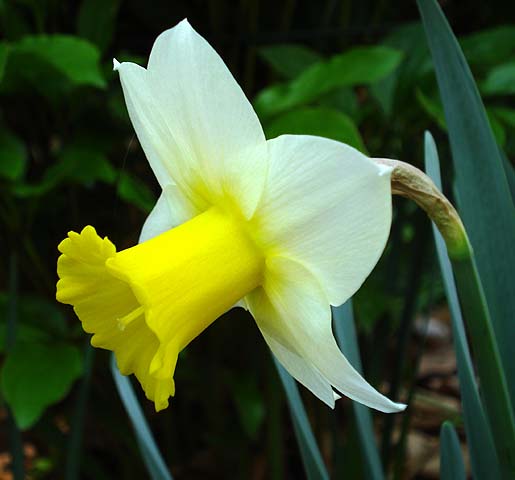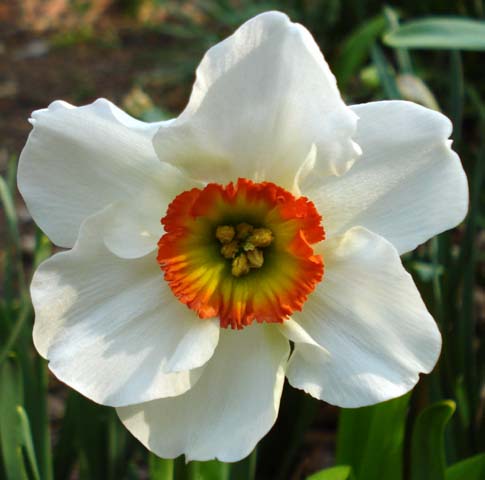If you live in the eastern half of the United States you probably noticed a big change in the weather last week. A strong cold front drove south all the way to the Gulf of Mexico and east to the Atlantic Ocean, spoiling many spring garden displays as it went. The weather station at the airport not far from here recorded a low temperature of 27°F early Sunday morning, it might have been a little warmer or colder here in the garden. As a gardener and lover of wild plants and the animals they feed and shelter, extreme weather events like this are very disturbing to me.
As much as it bothers me, I decided to record the freeze damage in the garden with the camera and then add more photos over the coming weeks and months to show how the plants recover from their injuries. All of the pictures will be of woody plants, both natives and exotics, that are growing in the garden or the adjacent forest. Yes, there was damage to herbaceous perennials also, but some of the most sensitive, such as Hostas, I covered with old blankets.
First up are the natives. These should be well adapted to our climate and not be fooled by the sometimes vague transition from winter to spring, but several weeks of warm weather got them to commit and they paid the price when the cold arrived.
Pawpaw (Asimina triloba)

Fringetree (Chionanthus virginicus)

Tulip Poplar (Liriodendron tulipifera)

Sourwood (Oxydendrum arboreum)

Several other natives were badly damaged by the freeze. I have photos of them but in the interest of column space I am not putting them inline and will link to them instead. They are Eastern Redbud (Cercis canadensis), Black Gum (Nyssa sylvatica), and Yellowwood (Cladrastis kentukea).
Next up are the exotic victims, all native to Asia, mostly Japan, and adapted to similar climates, although perhaps not so uneven in the spring as the Eastern United States. In the photo of Japanese Spicebush below, note that the leaves are undamaged but the new shoot to which they're attached is limp. Hard to say what will happen as they continue to grow, but I'll be watching.
Japanese Clethra (Clethra barbinervis)

Weeping Katsuratree (Cercidiphyllum japonicum 'Pendula')

Crapemyrtle (Lagerstroemia 'Muskogee')

Japanese Spicebush (Lindera obtusiloba)

The good news is that most of the plants in the garden, native and exotic alike, got through this late cold snap with little or no damage. Here's the complete report for my garden.
No visible damage
Acer leucoderme, Acer rubrum, Adiantum pedatum, Aesculus parviflora, Aesculus sylvatica, Ajuga reptans, Allium 'Millenium', Alpinia japonica, Amelanchier arborea, Amsonia hubrechtii, Anemonella thalictroides, Aquilegia canadensis, Arum species and hybrids, Aster divaricatus, Athyrium filix-femina, Baptisia minor, Baptisia 'Carolina Moonlight', Baptisia 'Purple Smoke', Chrysogonum virginianum, Clematis species and hybrids, Clinopodium georgianum, Colchicum species and hybrids, Coreopsis verticillata, Cornus florida, Cornus kousa, Crataegus phaenopyrum, Dicentra eximia, Dicentra spectabilis, Disporopsis pernyi, Disporum flavens, Dracunculus vulgaris, Dryopteris species and hybrids, Epimedium species and hybrids, Erythronium species and hybrids, Eucomis species, Eupatorium rugosum, Fagus grandifolia, Geranium species and hybrids, Habranthus species and hybrids, Hamamelis species and hybrids, Helleborus × hybridus, Hesperis matronalis, Heuchera americana, Hydrangea quercifolia, Hymenocallis species and hybrids, Illicium floridanum, Iris species and hybrids, Leucojum species, Liquidambar styraciflua, Liriope muscari, Lobelia cardinalis, Lonicera sempervirens, Lycoris species and hybrids, Magnolia stellata, Mertensia virginica, Myosotis sylvatica, Narcissus species and hybrids, Oenothera fruticosa, Ostrya virginiana, Paeonia species and hybrids, Parrotia persica, Parthenocissus quinquefolia, Phlox divaricata, Phlox paniculata, Polygonatum caniculatum, Polygonatum humile, Polygonatum odoratum, Polystichum acrostichoides, Primula kisoana, Primula vulgaris, Prunus mume, Rhododendron atlanticum, Rosmarinus officinalis, Salvia guaranitica, Salvia lyrata, Salvia × superba, Scilla natalensis, Scilla peruviana, Scilla sibirica, Sedum species and hybrids, Smilacina racemosa, Stokesia laevis, Stylophorum diphyllum, Thymus species, Tiarella cordifolia, Thalictrum kiusianum, Trachycarpus fortunei, Tradescantia species and hybrids, Trillium species, Uvularia species, Vaccinium species, Verbena canadensis, Veronica species and hybrids, Viburnum species, Viola species, Woodwardia areolata, Zephyranthes species and hybrids
Some damage
Acer japonicum, Aesculus pavia, Agarista populifolia, ×Amarcrinum, Anemone hybrids, Astilbe species and hybrids, Athyrium niponicum, Baptisia alba, Camellia species and hybrids, Carya species, Corydalis 'Blackberry Wine', Crinum species and hybrids, Farfugium japonicum, Fothergilla 'Mt. Airy', Hemerocallis hybrids, Hippeastrum hybrids, Itea virginica, Lindera obtusiloba, Magnolia sieboldii, Musa velutina, Nandina domestica, Quercus species, Rhododendron canescens, Salvia microphylla, Stewartia pseudocamellia, Styrax species
Severe damage
Acer palmatum, Asimina triloba, Bletilla striata, Buddleia species, Cercidiphyllum japonicum, Cercis canadensis, Cladrastis kentukea, Clethra barbinervis, Chionanthus virginicus, Corylopsis pauciflora, Ilex species, Lagerstroemia hybrids, Liriodendron tulipifera, Nyssa sylvatica, Osmanthus species and hybrids, Oxydendrum arboreum, Perovskia atriplicifolia
No damage, still dormant
Alpinia pumila, Asclepias tuberosa, Callicarpa species, Canna hybrids, Clethra alnifolia, Cryptomeria japonica, Curcuma species and hybrids, Eupatorium maculatum, Hedychium species and hybrids, Hibiscus coccineus, Lavandula species, Osmunda species, Magnolia grandiflora, Magnolia tripetala, Musa basjoo, Musa itenerans, Rhododendron catawbiense, Rohdea japonica, Thelypteris species, Tsuga canadensis



























